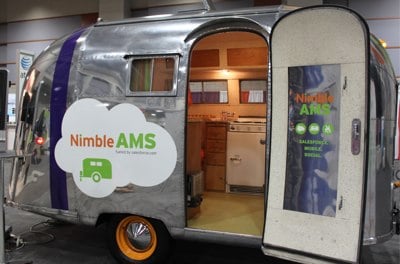It was big news—less than 3 weeks ago—when YourMembership announced the formation of Community Brands with the acquisition of Abila and Aptify. [Here's what you need to know about that.] Yesterday, JP Guilbault announced that NimbleUser is joining the fold. Aside from the speed of this new addition to Community Brands, it is in and of itself notable because of the type of AMS vendor Nimble is.

Why Nimble?
In the last few years, a handful of vendors using Salesforce CRM and Microsoft Dynamics CRM as the underlying platform for their AMSes have popped up, giving traditional vendors a competitive headache. The rising popularity of Salesforce and Microsoft Dynamics CRM—whether theoretical or actual—has spurred some excitement in the market that hadn’t been seen in some time.
Enterprise-level vendors, such as Abila and Aptify, touted lack of dependence on a commercial platform, roadmaps that were tailored to associations, simpler and less expensive licensing costs, and deeper functionality. The fact that NimbleUser, one of the major players in the Salesforce-based AMS market, is now joining a family that includes SaaS and traditional enterprise AMS products is interesting indeed.
What’s the point? Community Brands is looking to cover the span of association/not-for-profit needs. By acquiring NimbleUser, they’ll be able to sell to the “gotta have Salesforce” mindset, too. If Community Brands decides to further specialize in the broader not-for-profit space with the products it now owns, it will create an even more interesting scenario.
What do we think will happen?
Unless Community Brands makes clear distinctions between products or sectors, there will likely be some nuanced differentiation—or even confusion—between enterprise-level products under the umbrella (namely, Abila and Aptify). After all, they have competed for years to the same prospective clients. Both are mature products that might not warrant further resource investment—this remains to be seen.
Perhaps the eventual road leads to investing heavily into adding new functionality that will impact all of the products or leverage the unique functionality of each product, thereby creating several flagship products differentiated by technology platform, marketplace, etc. Perhaps.
I am concerned that the AMS market is crowded and that some consolidation is probably needed. There are other potential paths, which we’ll address in the future.
What else do we think will happen?
A lot depends on the roadmap that is developed for Community Brands—in general and for each product.
Will Community Brands use this opportunity to bring discipline and a fresh perspective to the current product development practices of vendors—those under the umbrella as well as those outside it? I would love to see a real shift to a proactive approach in the AMS industry, instead of the reactive approach of ‘enhancing’ baseline systems based on customer requests.
Will Community Brands help AMSes focus on solving business problems and incorporate new opportunities for associations? A larger question is whether customers will continue to select traditional AMSes that offer a wide variety of features within a single product or move toward platforms that allow customers to add features using apps and partner products.
How will Community Brands’ latest acquisition and growing family of products impact associations? We’ll provide updates as the story unfolds—subscribed to our blog and follow us on Twitter to stay in the know.
photo: nimberuser.com
